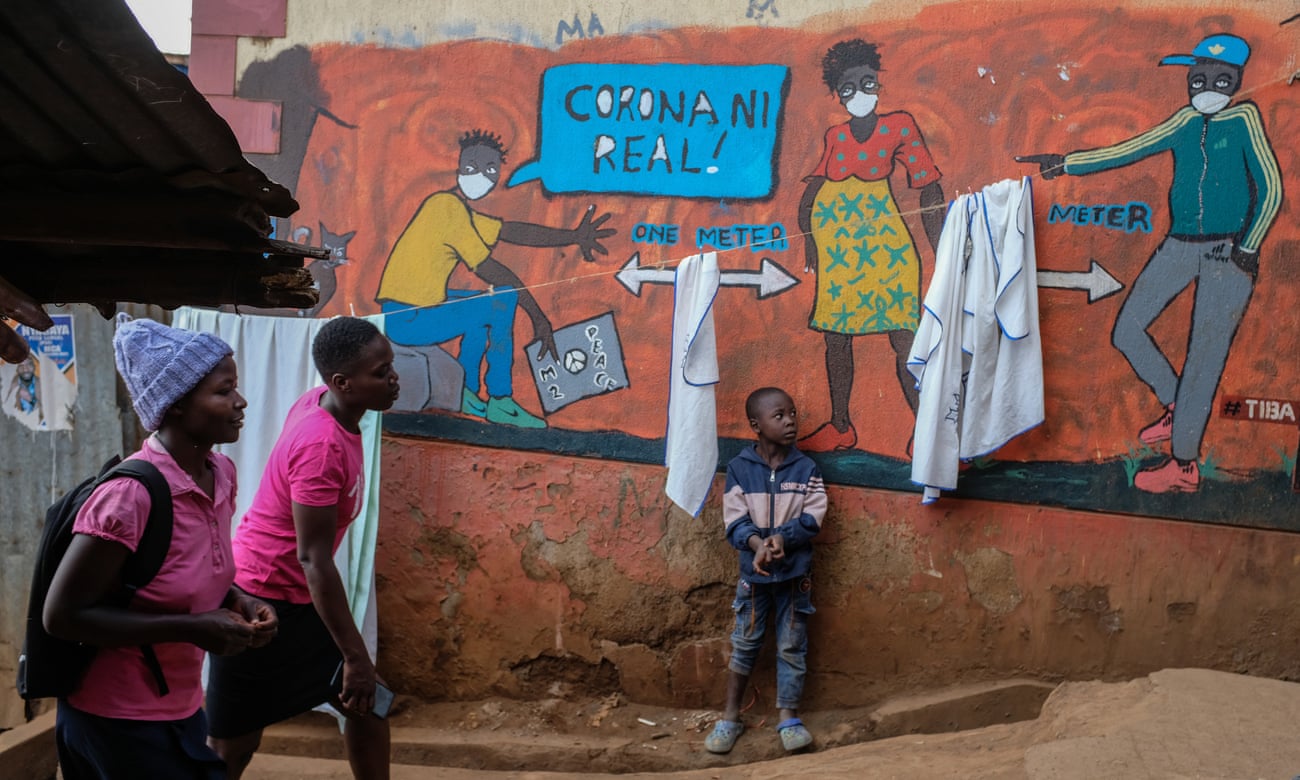As research focuses on richer parts of world, people in less developed countries suffer from lack of awareness and support

www.theguardian.com
Thomas Graham in La Paz,
Amrit Dhillon in Delhi and
Caroline Kimeu in Nairobi
Thu 13 Jul 2023 11.00 EDT
‘No one is talking about it’: the cruelty of long Covid in the global south
Doctors in Nairobi said greater awareness of long Covid was necessary. Photograph: Sopa Images/LightRocket/Getty Images
As research focuses on richer parts of world, people in less developed countries suffer from lack of awareness and support
In the Hospital del Norte of El Alto, a working-class city in
Bolivia, visibly sick patients queue for a consultation with a surgeon. At their feet, two stray dogs sleep on a floor strewn with coca leaves.
Dr Silverio Condori, 49, was here when
the coronavirus pandemic arrived in Bolivia. He fell sick in June 2020 and spent two months in one of the country’s few intensive care units. “I came back from another world,” he said.
“When I got out of hospital, I had to learn to walk, to eat, even to speak,” Condori added, pointing to a neat horizontal tracheotomy scar at the base of his throat. “I still have some paralysis in my right side. I’m a surgeon, but I can’t operate. At least I’m still here, thank God.”
Condori is one of what is surely a great number of people living with the after-effects of Covid-19 in low- and middle-income countries like Bolivia.
But as almost all research on
long Covid has focused on richer countries, there is little sense of the scale and nature of the health burden in such places – nor is there awareness and support for those suffering from it.
The WHO
defines long Covid as the otherwise unexplained continuation of symptoms three months after the initial infection. Common symptoms include fatigue, shortness of breath and cognitive dysfunction – but more than 200 have been reported.
Perhaps 10% of those with infections confirmed by test or hospital admission may go on to develop it, though symptoms can subside with time.
A mobile vaccination and testing medical unit in La Paz, Bolivia, where long Covid is going largely undocumented. Photograph: Aizar Raldes/AFP/Getty Images
With 651m documented Covid cases worldwide, that would mean
65 million individuals have long Covid.
But this could be an underestimate, given that many people were never tested, or treated themselves at home, and so their cases went undocumented.
Still, as the acute urgency of the pandemic faded, attention moved on, especially in the developing world. In Bolivia, not one study has been published on long Covid, and almost nothing has been written in the press. “No one is talking about it,” said Condori.
This lack of attention is essentially common across the global south, according to Dr Juan Carlos Villar, co-chair of the
Clinical Epidemiology Working Group, which is developing a pilot study on long Covid in low- and middle-income countries.
“Here in Colombia, long Covid is absolutely underappreciated,” said Villar. “You can see that some people in government might be aware of it, but no one wants to speak about it. Because they know it’s going to be problematic.”
The Guardian interviewed people suffering from long Covid in Bolivia, Kenya and
India, all of whom had to go to great lengths to find their own diagnoses and treatments.
Megan Murray: ‘No one took me seriously.’ Photograph: Megan murray
For Megan Murray, a 34-year old singer in Goa, India, sadness at having lost two years of her life is accompanied by anxiety over
what the virus has done to her organs. “I want to get married and have children, and I can’t help worrying about what future health issues might spring up,” said Murray.
After her initial infection in April 2021, Murray continued to suffer from muscle cramps, gut issues, dizziness, tachycardia and fatigue that made just walking to the bathroom an ordeal. The doctors she consulted treated her like a hypochondriac.
“No one took me seriously,” said Murray. “I thought I was going crazy until a friend in New York said it might be long Covid.”
In September 2021, the Indian government released a set of guidelines for managing long Covid – the first official acceptance that the problem needed special attention.
By then, Murray had already travelled to the US for treatment, starting her long and still uncertain recovery. Though there are long Covid clinics in India, she was unaware of their existence – and in such a vast country, where tens of millions may have experienced symptoms, a handful of clinics is unlikely to be enough.
Muthoni Njogu described a similar experience in
Kenya where, two years after testing positive for Covid-19, the 46-year-old said she had “never recovered”.
Njogu has had myasthenia gravis, a muscle-weakening autoimmune disease, for most of her adult life. But she says long Covid has effectively disabled her, with fatigue, brain fog and memory lapses, as well as cardiac and respiratory symptoms.
Muthoni Njogu: ‘I still look healthy … but I can barely walk 10ft.’ Photograph: Muthoni Njogu
“My body feels like I’m in my 80s,” said Njogu. “I still look healthy … but I can barely walk 10ft.”
Like Murray, Njogu says she has had to advocate for herself with her doctors and be proactive in her treatment. “A lot of doctors [here] don’t know about long Covid,” she said.
Duncan Nyukuri, a doctor at the Kenyatta national hospital who helped develop Kenya’s Covid-19 guidelines, said that, while there was “some acceptance” among the medical fraternity about the existence of long Covid, greater awareness was necessary.
Last year, the Kenyatta University teaching referral and research hospital
launched an investigation into long Covid with multilateral health organisations – a step to address the uncertainty that shrouds the condition.
“Very little is known about the burden of this problem especially in Africa and what makes some people more likely to have it,”
said the research hospital, whose studies are ongoing.
Back in Bolivia, in La Paz, Emilia Cardozo, an 18-year old student, described the symptoms set off by her Covid infection, which included back pain so severe she was hospitalised, followed by partial deafness and blindness in her right eye.
These symptoms subsided after a few months, but others remained. “My hair was falling out in clumps; my nails stopped growing; my skin was very irritated. And I was still tired: too tired. There are days when I sleep all day but still feel tired.”
When Cardozo consulted doctors, they put it down to stress. She had encountered the same thing as a child, when it took her six years to receive a diagnosis for dysautonomia, a condition of the autonomous nervous system that few doctors in Bolivia were familiar with.
“When you still have symptoms a year later and they tell you that it’s all stress, this affects you psychologically, too,” said Cardozo. “Because you really don’t know; you’re not a doctor. You try to find solutions, but there’s no one to guide you. Everyone’s just trying to treat themselves.”
Cardozo acknowledges that she was relatively fortunate: she could access information in English online and spend on private healthcare. “But people in rural areas or who don’t have the money won’t be able to do the same. Maybe there are a huge number of people living with long Covid that don’t even know it.”
Villar believes that many people in low- and middle-income countries have a “higher threshold for complaints” due to necessity and lack of resources. Even if they are suffering from some residual effects of Covid, perhaps they don’t – can’t – pay attention to them.
“When I was a junior doctor in public hospitals [in Colombia], people would only turn up when they literally couldn’t walk or swallow any more,” said Villar. “And in the mental health facilities, we only saw patients with wild episodes of psychosis, or depression that was almost catatonic.”
Dr Silverio Condori: ‘I’m a surgeon, but I can’t operate.’ Photograph: Dr Silverio Condori
“Having relatively minor depression was labelled as something of the elite. Depression, fatigue, insomnia: these were for rich people.”
One Bolivian doctor, who asked to remain anonymous, said that, even if long Covid seems invisible in poorer countries, it will only add to the daunting burden of chronic diseases that they face. “I think we’re going to see consequences in the coming years, and we won’t know whether to attribute them to Covid.”
Public healthcare, where it exists, may lack the resources to treat such conditions. People’s ability to work will be affected.
“Countries like Bolivia are not equipped to evaluate this kind of health economics,” said the doctor. “The fundamental they deal with is deaths – they’re not thinking in terms of years of life lost, disability, quality of life.”
Countries around the world will struggle to quantify the health burden from long Covid. And if long Covid is understudied, that is doubly true in the global south, said Villar.
But even so, the governments and medical systems in such countries may have other, greater public health concerns.
Dr Caroline Hilari, who coordinates a long Covid study in children in Bolivia with GIZ, a German development agency, says that interest in Covid among the medical profession had faded since the acute phase of the pandemic, and that other doctors often ask them why they are looking at long Covid at all. “It’s not a huge, huge public health problem,” she said. “But over half of the kids in our study are symptomatic.
“I think the fact that long Covid has not been in the media here is basically because we have more deadly diseases,” she added. “Just recently we’ve had kids dying of dengue and scorpion stings. When people die, that gets into the media. But chronic, disabling conditions do not – and maybe that’s the cruelty of being in a less developed country.”

















